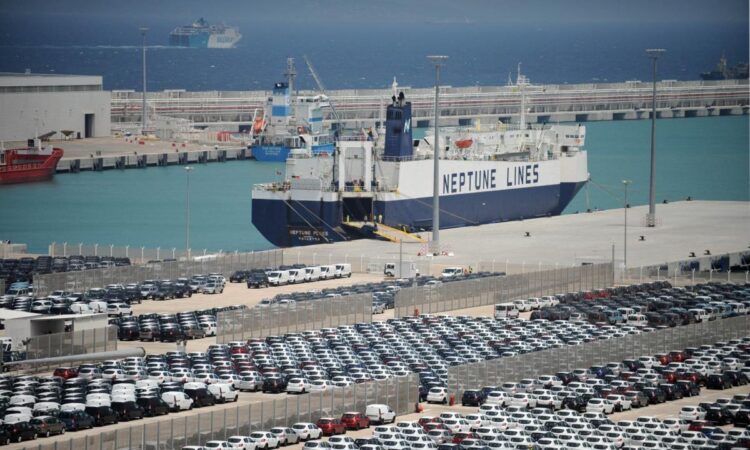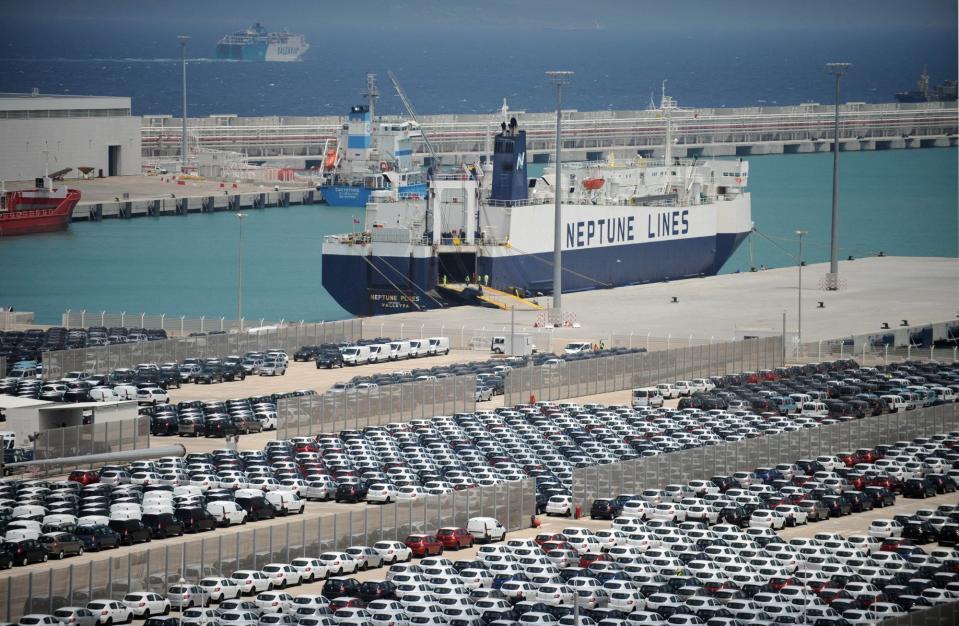
Just outside the Moroccan city of Tangier, a Chinese-backed manufacturing and technology hub is finally taking shape, after six years of delays.
The Mohammed VI Tangier Science and Technology City lies just 27km (16.8 miles) from the southern tip of the Spanish coast across the Strait of Gibraltar, strategically positioned where Africa faces Europe at the intersection of the Atlantic Ocean and the Mediterranean Sea.
First proposed in 2016 when Morocco’s King Mohammed VI met Chinese President Xi Jinping in Beijing, the US$1 billion tech city is eventually expected to host around 200 Chinese companies, all clamouring to gain easy access to Europe and Africa as part of China’s multibillion-dollar Belt and Road Initiative.
Do you have questions about the biggest topics and trends from around the world? Get the answers with SCMP Knowledge, our new platform of curated content with explainers, FAQs, analyses and infographics brought to you by our award-winning team.
After the initial Chinese sponsor – aviation giant Haite Group – withdrew in 2021 over issues concerning the project scale and ownership of the city, the plan finally got off the ground last year following a Moroccan government deal with other China-based firms.
Chinese ambassador to Morocco Li Changlin said that project – “which the two heads of state are jointly concerned about” – had made “significant progress” and was “1699774117 ready to receive investment from China and other countries”.
“China is expected to become a key participant in Morocco’s electric vehicle industry and contribute to Morocco’s industrialisation process,” Li wrote in an article on November 1 marking the 65th anniversary of bilateral diplomatic relations.
Observers said Morocco’s proximity to Europe, abundance of critical minerals, tax incentives and free-trade agreements with both the EU and the US have attracted a growing number of Chinese companies to build supply chains there, so as to strengthen China’s leadership in the EV sector.
For instance, Chinese battery parts maker CNGR Advanced Material announced in September it was teaming up with Moroccan private investment fund Al Mada to build a US$2 billion industrial base.
Sino-German electric vehicle battery maker Gotion High-Tech also plans to build a US$6 billion factory in Morocco to produce electric car batteries and energy storage systems.
Youshan, the subsidiary of China’s biggest cobalt refiner Huayou, is partnering with South Korea’s LG Chem to build a lithium iron phosphate (LFP) cathode materials plant in Morocco for the US market.
Among the first companies to break ground in the Tangier Science and Technology City was Qingdao Sentury Tyre Company, which has pumped nearly US$300 million into building a factory there. It recently signed a 20 hectare (49.4 acre) land purchase contract for the site, Li said.
By setting up a factory, the Chinese tyre company is looking to meet growing demand from vehicle manufacturers while taking advantage of Morocco’s prime geographic positioning for easy distribution to Europe.
Morocco is already a major vehicle manufacturing hub for European giants Stellantis and Renault, producing about a million units per year.
They are based in Kenitra, about 200km south of Tangier and 40km north of Moroccan capital Rabat, where the Atlantic Free Zone plays host to a large number of major vehicle and parts makers.
Rabat is now positioning itself as an EV manufacturing hub – and Chinese companies are at the centre of the ambitious plans.
Abdelmonim Amachraa, a Moroccan specialist on sustainability and global value chains, said as a key market for EVs, Europe is a strategic destination for Chinese companies looking to quickly supply their customers.
He said China’s expansion of global value chains in countries like Morocco can help Beijing get closer to European carmakers and the European market, reducing transport distances and electric vehicle production costs.
The strategic partnership between China and Morocco therefore represents the second stage of the African automotive ecosystem, he added.
“Morocco has successfully connected Africa to Europe through its dynamic automotive sector. France and Germany are excellent partners, and American companies also have a significant presence. Now, the question is whether Morocco can serve as a pivot between Asian value chains and Europe while strengthening China’s leadership in the electric vehicle sector,” he said.
Dr John Calabrese, a senior fellow at the Middle East Institute, said the Pan-Euro-Mediterranean (PEM) agreement gives Morocco the ability to export into the European Union on a tariff-free basis.
“And Morocco also has a free-trade agreement with the United States,” Calabrese said.
Last year Morocco announced the discovery of large deposits of lithium in the area bordering Mauritania and is also home to the world’s largest phosphate reserves. This makes it a “natural” candidate for the construction of LFP battery plants, Calabrese said.
“Moroccan scientist Rachid Yazami and his team have apparently developed a way to substantially reduce EV battery charging time,” Calabrese said. “It looks as though Asian EV producers recognise that Morocco is the ‘complete EV package’ for penetrating the European and American markets – and are competing with each other for a piece of the action.”
Zakia Subhan, head of Middle East and Africa Forecasting, and David Leah, a senior analyst at Powertrain Forecast, both part of LMC Automotive, said Morocco’s free-trade agreement with both the EU and the US puts Chinese companies in a more favourable position to benefit from subsidies under the US Inflation Reduction Act, as well as policies in relation to the EU’s Critical Raw Materials Act.

Renault vehicles lined up at the Tangier-Med container port. Photo: AFP alt=Renault vehicles lined up at the Tangier-Med container port. Photo: AFP>
The analysts said Morocco’s two industrial platforms, Tangier and Kenitra, have been granted free zone status – a total exemption from corporate tax for companies operating in these zones for five years, followed by a cap of 8.75 per cent for the next 20 years.
It makes the African nation an attractive option, given that transit time from Morocco to Spain is just a day or two, while labour costs are around a quarter of those in Spain and slightly lower than in eastern Europe.
Morocco is also part of the African Continental Free Trade Area, a massive zone bringing together the 55 countries of the African Union and eight regional economic communities. This means anything companies produce in Morocco can easily be exported within Africa, said Lauren Johnston, associate professor at the University of Sydney’s China Studies Centre.
“Morocco is also uber close to the EU market and moreover it has good ties with the US and UK. So perhaps it can even reach those markets. It is a geographic middle kingdom,” Johnston said.
The country also has a solid pre-existing auto sector and it already produces car parts, she added.
“So perhaps they [Chinese companies] can build from there.”
It is an example of the more general global trend towards nearshoring. Francois Conradie, the lead political economist at Oxford Economics Africa, said multinational industrial firms with long supply chains are planning to shorten and diversify them, and move production closer to the end client.
In North Africa, Morocco and Egypt have been big beneficiaries of this, he said, as firms establish production facilities near the European market.
“EV manufacturers, especially Chinese ones, are pivoting to lithium iron phosphate batteries, and phosphates are abundant in Morocco,” Conradie said.
Michel Jacinto, senior associate of light vehicle sales forecasts for Morocco, Algeria, Egypt and Iran at S&P Global Mobility, said Europe could become a major market for batteries made in Morocco as the EU announced the end of internal combustion engines for new vehicle registrations after 2035.
Plus, he said, increasingly the EU will pay closer attention to the amount of carbon dioxide emissions across a battery’s entire life cycle, starting with the extraction of raw materials and including assembling, transport and recycling.
“So having batteries made in Morocco, close to the OEM’s [original equipment manufacturer’s] plants, will be an advantage – versus batteries that could come from Japan, South Korea or China,” Jacinto said.
This article originally appeared in the South China Morning Post (SCMP), the most authoritative voice reporting on China and Asia for more than a century. For more SCMP stories, please explore the SCMP app or visit the SCMP’s Facebook and Twitter pages. Copyright © 2023 South China Morning Post Publishers Ltd. All rights reserved.
Copyright (c) 2023. South China Morning Post Publishers Ltd. All rights reserved.






